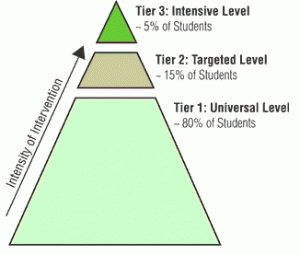RTI follows the following framework:

Tier 1 is the core curriculum within the classroom. It is defined by high quality instruction in all classes. Teachers differentiate instruction according to the students needs. If the teacher thinks that the student may benefit from additional or supplemental instruction, a referral is made to RTI. The referral form can be found on the “Faculty Common Space” drive-under RTI 2014.
The PST meets to discuss the students needs, a file review is conducted by the RTI teacher and if agreed upon by the team, the STAR assessment can be administered. The PST meets to discuss whether the student would benefit from a Tier 2 intervention. Tier 2 is during study hall for 40 minutes. Tier 2 has three characteristics that distinguish it from Tier 1(core instruction): 1.) It is evidence based 2.) it consists of small group instruction and 3.) it involves a clear action plan that is articulated to the PST and implemented with fidelity. The goal of Tier 2 is to remediate academic skill deficits so the student can be successful in Tier 1. It is usually short-term.
The RTI teacher will give the STAR assessment to determine if the student is making gains(4-6 weeks). If yes, continue with Tier 2, if no, increase time and frequency and go to Tier 3. Instruction is provided in Tier 3 by using an evidence based program to accelerate the skill/learning proficiency.
If progress is not noted after 6-12 weeks, a referral to special education may be warranted. Again, this depends on what the PST agrees upon. A revised action plan for student; involvement with parents, guidance counselors and other PST members make that determination.
Finally, the delivery of an effective tiered instructional model requires strong communication across those involved in the problem solving team. Teachers need to have clear and direct lines of communication with parents, administrators, teachers and guidance counselors. For RTI to work successfully the building consensus needs to be on-board with the model and effectiveness of the intervention. In addition, it is best to visit with other schools to view how RTI is being used at the junior high and secondary school level. Data meetings, especially at the transition years(8th grade to the high school) is essential to prevent drop-out rates and attendance issues.
